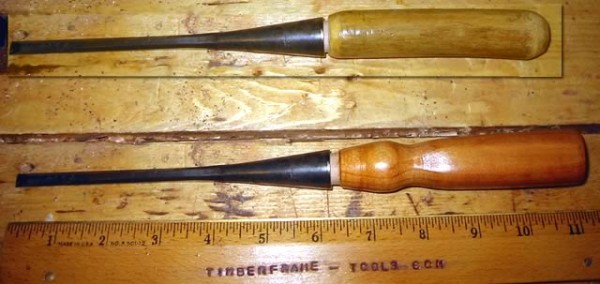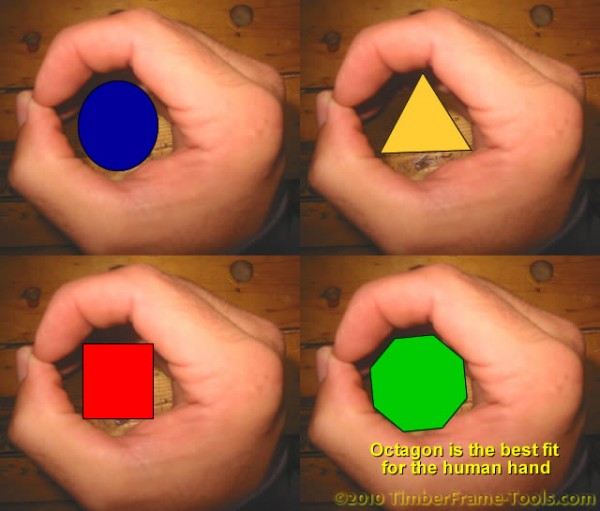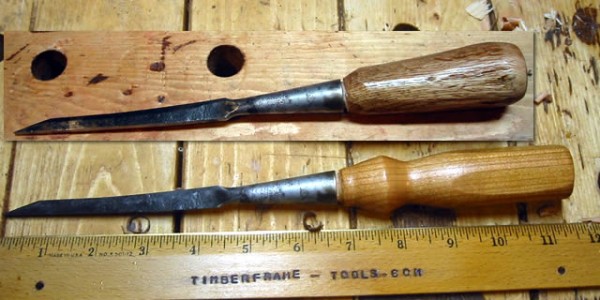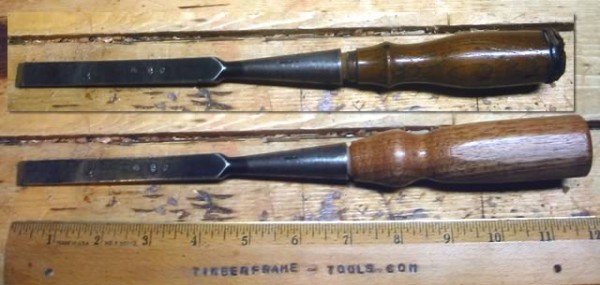I have an odd collection of chisels ranging from a couple of modern plastic handled abominations to several old Stanley 750’s , an old Witherby, a PS&W and a D.R. Barton. I am gradually replacing the plastic handled chisels as I find older socket handled varieties.
I like my old chisels, some belonged to my grandfather, some were my father’s and others I have picked up here and there. My only real complaint is that they all have different handles on them. The lengths and contours are all different so they all feel different when I am using them, not to mention they look pretty rag-tag. So I have set out with the help of my bungee lathe to create some new chisel handles. I’ll cover the actual how-to in my next post. Of all my assorted chisels I like the handle on my Witherby firmer chisel the best, so I used that as my starting point. Basically I duplicated the contours, and made it just a weee bit longer. And of course, it had to have some octagonal flats.

This handle on my 3/4" Witherby firmer chisel is my starting point. I like the overal shape but want it a bit longer so my pinky does not fall off the end.
Why Octagonal Chisel Handles?
Octagonal flats on a chisel handle are good design for a few reasons. The first is safety. An octagonal handled chisel is much less likely to roll off the bench and onto a foot or to the ground. The other reason is for ergonomics. An octagonal shape fits a human hand better than round square or triangular. Here, see for yourself.
The hand when wrapped around a handle has its own flats. It actually forms seven flats rather than eight, but seven flats are a lot more difficult to create and not worth the extra effort. Most modern chisels have round handles, but there are still several models that have octagonal regions. (Pfeil cabinet maker and Pfeil butt chisels, Sorby, Hirsch, Two Cherries, and Bracht come to mind)
I should point out that my hands are not what I would consider larger than average. If anything, they are likely smaller than average. However, I find the larger diameter and longer length to make the chisel more comfortable to use and more controlled.
So here are the results of my replacements, again I’ll be covering the how, in my next post.
The first handle re-make was on my large 1-1/2″ D. R. Barton firmer chisel. This one is large enough that it could also be classified as a timber framing chisel. When I purchased this on eBay it had no handle. This is what it looks like with my newly made handle of cherry.

This D.R. Barton is larger in scale than my others so as a result the handle is a touch larger than the others.
Next up was an 1/8″ mortise chisel that came from my Father. It is unmarked and had a crudely fashioned oak handle I made a couple of decades ago. No longer embarrassing and a pleasure to use.
On to a 1/4″ Stanley that was also my Father’s. This is likely a Stanley 750, but it is unmarked as to model number, only markings are “Stanley” on the back and “Made in USA” on the socket. It had no handle, so a long time ago I made one for it from a hornbeam branch. A hard solid handle, but ugly and not that comfortable.

1/4" Stanley originally had a hornbeam branch for a handle, looking more refined with a cherry handle
The chisel I reach for most often is a 1/2″ Stanley 750. It had the original Stanley handle, which I think are too short and too small. I think this new handle is a big improvement. The wood is a bit of a mystery, I think it is possibly butternut or light walnut.
A 1/2″ P.S. & W Co firmer chisel. This one probably had its original handle which was similar to the Witherby, but a touch shorter. It now sports a handle of the same mystery wood as its Stanley 1/2″ brother.
Another Stanley 750. This one is an inch wide and came from an antique store with its original handle in place. Again, too small a handle for my comfort. It gets a mahogany handle.
And here is the whole set of wood handled socket chisels. The 4 plastic handled chisels in my collection are hiding from embarrassment. They rarely get used, typically for outdoor and more risky chiseling.

Some slight variation in sizes, mainly due to my deficiencies in lathe skills, but generally the handles all look and feel the same.
Hmm… now that poor Witherby that I used as the pattern looks a bit out of place. I’ll have to make one more handle for it.
Next up, I’ll cover making the chisel handles.
Resources related to octagonal chisel handles
- Stephen Shepherd at Full Chisel Blog showing his octagonal tool handles and discussing their safety.
- Don McConnell on making octagonal chisel handles (PDF)
- J. Alexander on making octagonal handles
- Making London Pattern Chisel handles (round on the ends, octagonal in the middle)
Sources for Replacement Chisel Handles
- Chisel Handles at Woodcraft
- Replacement Chisel handles at Amazon.com
1 2 >>
I have an odd collection of chisels ranging from a couple of modern plastic handled abominations to several old Stanley 750’s and a pair of old whetherbys. I am gradually replacing the plastic handled chisels as I find older socket handled varieties.
I like my old chisels, some belonged to my grandfather, some were my fathers and other’s I have picked up here and there. My only real complaint is that they all have different handles on them. The lengths and contours are all different. So I have set out with the help of my bungee lathe to create some new ones. Of all my assorted chisels I like the handle on my Whetherby registered chisel the best, so I used that as my starting point.
Basically I duplicated the contours, and made it just a weee bit longer.
I use the parting tool to create the shoulder for the chisel socket, then all the other contour lines are made relative to the shoulder location.
After shaping and smoothing




